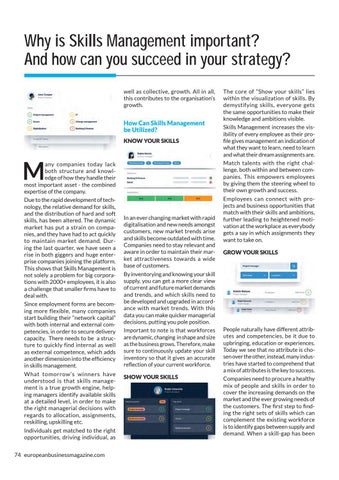Why is Skills Management important? And how can you succeed in your strategy? well as collective, growth. All in all, this contributes to the organisation’s growth.
How Can Skills Management be Utilized? KNOW YOUR SKILLS
M
any companies today lack both structure and knowledge of how they handle their most important asset - the combined expertise of the company. Due to the rapid development of technology, the relative demand for skills, and the distribution of hard and soft skills, has been altered. The dynamic market has put a strain on companies, and they have had to act quickly to maintain market demand. During the last quarter, we have seen a rise in both giggers and huge enterprise companies joining the platform. This shows that Skills Management is not solely a problem for big corporations with 2000+ employees, it is also a challenge that smaller firms have to deal with. Since employment forms are becoming more flexible, many companies start building their “network capital” with both internal and external competencies, in order to secure delivery capacity. There needs to be a structure to quickly find internal as well as external competence, which adds another dimension into the efficiency in skills management. What tomorrow’s winners have understood is that skills management is a true growth engine, helping managers identify available skills at a detailed level, in order to make the right managerial decisions with regards to allocation, assignments, reskilling, upskilling etc. Individuals get matched to the right opportunities, driving individual, as
74 europeanbusinessmagazine.com
In an ever changing market with rapid digitalisation and new needs amongst customers, new market trends arise and skills become outdated with time. Companies need to stay relevant and aware in order to maintain their market attractiveness towards a wide base of customers. By inventorying and knowing your skill supply, you can get a more clear view of current and future market demands and trends, and which skills need to be developed and upgraded in accordance with market trends. With this data you can make quicker managerial decisions, putting you pole position. Important to note is that workforces are dynamic, changing in shape and size as the business grows. Therefore, make sure to continuously update your skill inventory so that it gives an accurate reflection of your current workforce. SHOW YOUR SKILLS
The core of “Show your skills” lies within the visualization of skills. By demystifying skills, everyone gets the same opportunities to make their knowledge and ambitions visible. Skills Management increases the visibility of every employee as their profile gives management an indication of what they want to learn, need to learn and what their dream assignments are. Match talents with the right challenge, both within and between companies. This empowers employees by giving them the steering wheel to their own growth and success. Employees can connect with projects and business opportunities that match with their skills and ambitions, further leading to heightened motivation at the workplace as everybody gets a say in which assignments they want to take on. GROW YOUR SKILLS
People naturally have different attributes and competencies, be it due to upbringing, education or experiences. Today we see that no attribute is chosen over the other, instead, many industries have started to comprehend that a mix of attributes is the key to success. Companies need to procure a healthy mix of people and skills in order to cover the increasing demands on the market and the ever growing needs of the customers. The first step to finding the right sets of skills which can complement the existing workforce is to identify gaps between supply and demand. When a skill-gap has been





































